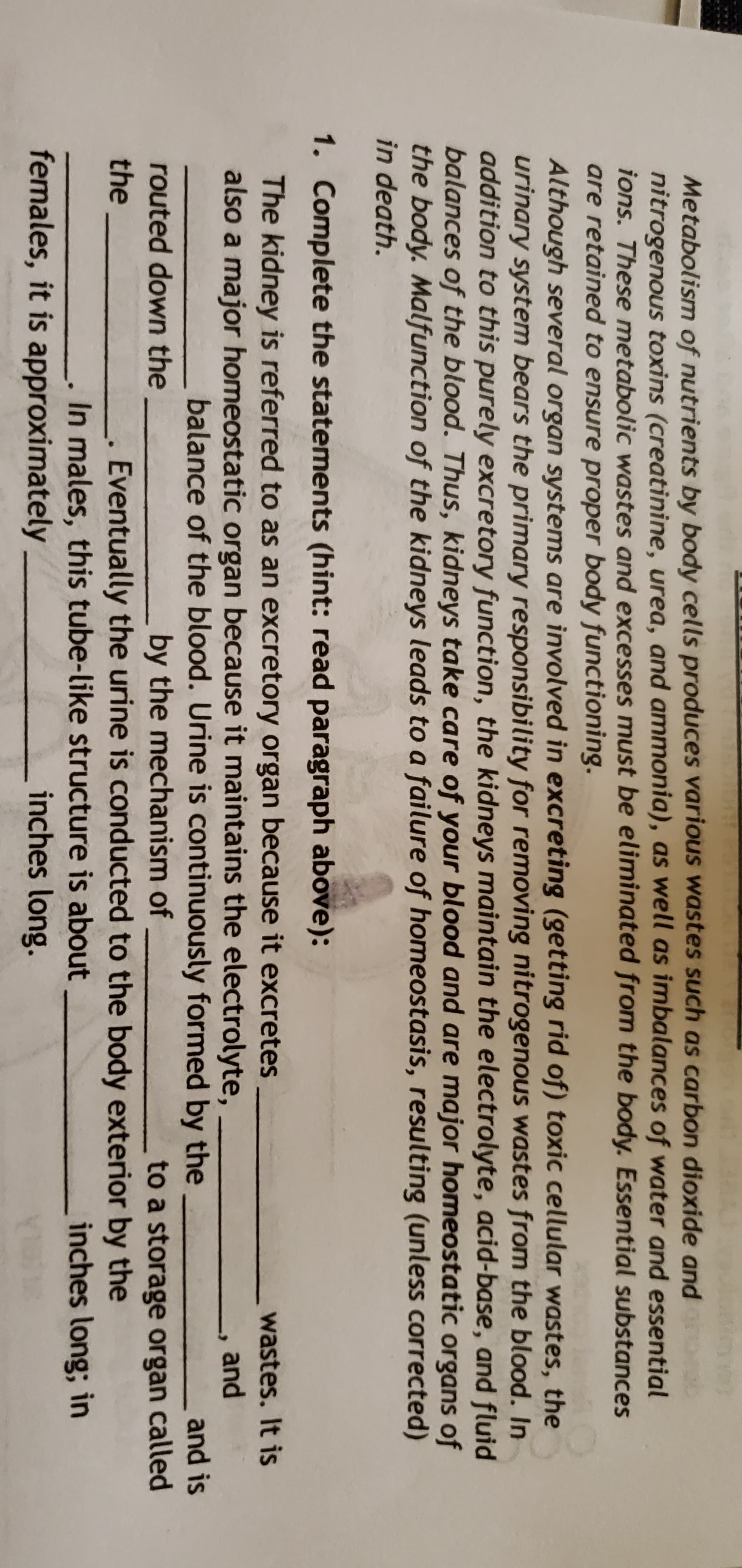Metabolism of nutrients by body cells produces various wastes such as carbon dioxide and nitrogenous toxins (creatinine, urea, and ammonia), as well as imbalances of water and essential ions. These metabolic wastes and excesses must be eliminated from the body. Essential substances are retained to ensure proper body functioning. Although several organ systems are involved in excreting (getting rid of) toxic cellular wastes, the urinary system bears the primary responsibility for removing nitrogenous wastes from the blood. In addition to this purely excretory function, the kidneys maintain the electrolyte, acid-base, and fluid balances of the blood. Thus, kidneys take care of your blood and are major homeostatic organs of the body. Malfunction of the kidneys leads to a failure of homeostasis, resulting (unless corrected) in death. 1. Complete the statements (hint: read paragraph above): The kidney is referred to as an excretory organ because it excretes also a major homeostatic organ because it maintains the electrolyte, balance of the blood. Urine is continuously formed by the wastes. It is and and is routed down the by the mechanism of to a storage organ called the Eventually the urine is conducted to the body exterior by the In males, this tube-like structure is about inches long; in females, it is approximately inches long.
Metabolism of nutrients by body cells produces various wastes such as carbon dioxide and nitrogenous toxins (creatinine, urea, and ammonia), as well as imbalances of water and essential ions. These metabolic wastes and excesses must be eliminated from the body. Essential substances are retained to ensure proper body functioning. Although several organ systems are involved in excreting (getting rid of) toxic cellular wastes, the urinary system bears the primary responsibility for removing nitrogenous wastes from the blood. In addition to this purely excretory function, the kidneys maintain the electrolyte, acid-base, and fluid balances of the blood. Thus, kidneys take care of your blood and are major homeostatic organs of the body. Malfunction of the kidneys leads to a failure of homeostasis, resulting (unless corrected) in death. 1. Complete the statements (hint: read paragraph above): The kidney is referred to as an excretory organ because it excretes also a major homeostatic organ because it maintains the electrolyte, balance of the blood. Urine is continuously formed by the wastes. It is and and is routed down the by the mechanism of to a storage organ called the Eventually the urine is conducted to the body exterior by the In males, this tube-like structure is about inches long; in females, it is approximately inches long.
Concepts of Biology
1st Edition
ISBN:9781938168116
Author:Samantha Fowler, Rebecca Roush, James Wise
Publisher:Samantha Fowler, Rebecca Roush, James Wise
Chapter16: The Body's System
Section: Chapter Questions
Problem 11RQ: Which of the following statements is not true? a. Essential nutrients can be synthesized by the...
Related questions
Question

Transcribed Image Text:Metabolism of nutrients by body cells produces various wastes such as carbon dioxide and
nitrogenous toxins (creatinine, urea, and ammonia), as well as imbalances of water and essential
ions. These metabolic wastes and excesses must be eliminated from the body. Essential substances
are retained to ensure proper body functioning.
Although several organ systems are involved in excreting (getting rid of) toxic cellular wastes, the
urinary system bears the primary responsibility for removing nitrogenous wastes from the blood. In
addition to this purely excretory function, the kidneys maintain the electrolyte, acid-base, and fluid
balances of the blood. Thus, kidneys take care of your blood and are major homeostatic organs of
the body. Malfunction of the kidneys leads to a failure of homeostasis, resulting (unless corrected)
in death.
1. Complete the statements (hint: read paragraph above):
The kidney is referred to as an excretory organ because it excretes
also a major homeostatic organ because it maintains the electrolyte,
balance of the blood. Urine is continuously formed by the
wastes. It is
and
and is
routed down the
by the mechanism of
to a storage organ called
the
Eventually the urine is conducted to the body exterior by the
In males, this tube-like structure is about
inches long; in
females, it is approximately
inches long.
Expert Solution
This question has been solved!
Explore an expertly crafted, step-by-step solution for a thorough understanding of key concepts.
This is a popular solution!
Trending now
This is a popular solution!
Step by step
Solved in 3 steps with 1 images

Recommended textbooks for you

Concepts of Biology
Biology
ISBN:
9781938168116
Author:
Samantha Fowler, Rebecca Roush, James Wise
Publisher:
OpenStax College

Concepts of Biology
Biology
ISBN:
9781938168116
Author:
Samantha Fowler, Rebecca Roush, James Wise
Publisher:
OpenStax College